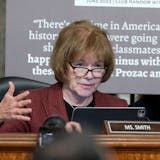Minnesota Gov. Tim Walz could become the next vice president of the United States after Democratic presidential nominee Kamala Harris picked him to be her running mate on Tuesday.
The DFL governor will join Harris on a battleground state tour this week. Walz had been an effective messenger for Democrats prior to being selected as Harris’ running mate, slamming Republicans such as former President Donald Trump and his running mate, Ohio U.S. Sen. JD Vance, as “weird people” and going viral in the process.
Walz’s journey to this moment has spanned decades. The 60-year-old was a soldier and public school teacher before being elected to Congress and later the governor’s office. His tenure as governor has had its highs and lows, from his criticized handling of the Minneapolis riots to a historically productive legislative session.
Here’s a look at his life and career:
From Nebraska to Mankato
Born in a small town in rural Nebraska, Walz enlisted in the Army National Guard when he was 17. He lost his father, a school administrator, to cancer two years later, a pivotal moment that saddled his mother with medical debt and fueled Walz’s views on health care access years later.
Walz graduated with a social science degree from Chadron State College in 1989 and spent a year teaching in China before returning full time to the Army. He was deployed overseas on active duty for months — although he never saw combat — and rose to the rank of command sergeant major before retiring from the military in 2005.
While teaching, Walz met his future wife, Gwen Whipple, a native Minnesotan. The two eventually moved to Mankato, where he taught and coached high school football and where they raised their two children, Hope and Gus.
In 2004, according to Walz, he and several of his students were blocked from entering a political rally for former President George W. Bush because a student was spotted with a John Kerry sticker. Despite having no political experience, a frustrated Walz signed up to help with Kerry’s campaign and decided to run for office.


